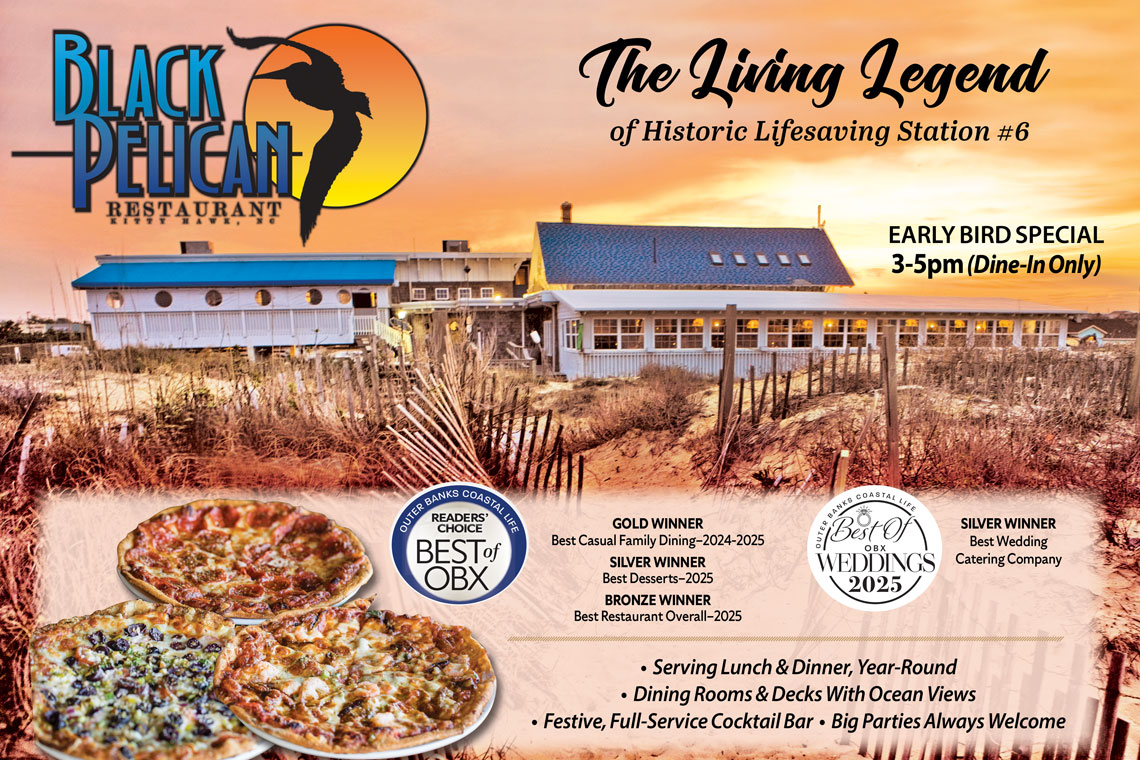Kitty Hawk may have rose to national fame with the arrival of the Wright Brothers, but the region was home to salty locals for centuries before the Wrights took flight. From the long lost soundside communities in Kitty Hawk Woods to the historic lifesaving station that guarded the coastline, Kitty Hawk has plenty of stories to share.
Facts
Modern archeologists estimate that Kitty Hawk was occupied for centuries before European explorers first discovered the region in the late 1500s.
Evidence of Algonquin speaking tribes exist in modern day Southern Shores and near the western edge of the Wright Memorial Bridge. Other tell-tale signs have been spotted in Kitty Hawk Woods, close to Shallbank Point. In fact, even the name "Kitty Hawk" seems to have ties to these first natives, as the original name, Chickenhauk, was noted on a New World map as early as 1738 - well before the region was fully explored.
Kitty Hawk would never receive the mass migration of settlers like nearby Roanoke Island and the North Carolina mainland, but a handful of New World residents were brave enough to set up a home in the region. Maps from the 1700s and 1800s note handfuls of privately owned plantations and residences, as well as a schoolhouse and other small businesses that's served the community.
This under-the-radar reputation would change when the Wright Brothers arrived in the region in 1900, and stayed for three years to perfect their powered flight experiments. While the historic December 17th First Flight actually launched via the sand dunes of neighboring Kill Devil Hills, Kitty Hawk nevertheless became famous as the birthplace of flight.
After the Wright Brothers passed through the area and made national headlines, Kitty Hawk somewhat retreated back to its quiet existence. The 1910s and 1920s were marked by the arrival of lumber businesses who harvested the Kitty Hawk Woods area.
Once the first Wright Memorial Bridge was constructed in the 1930s, linking the off-shore beach town to the mainland, tourism began to steadily develop. This would continue in the following decades, (and coincide with multiple Wright Memorial Bridge renovations), until eventually Kitty Hawk would be in the national spotlight once again - this time as one of the premier vacation destinations along the Outer Banks.
Events
Kitty Hawk's history dates back hundreds if not thousands of years, and the following timeline provides a brief overview of this small town's national claims to fame, or landscape-changing events.
- Pre-1600s - Small communities of Native Americans live on the soundside of Kitty Hawk. These communities are located in the Kitty Hawk Woods and close to the Currituck Sound waters adjacent to the Wright Memorial Bridge
- July 1584 - Captain Phillip Armadas find an entry to the New World through the North Banks, passing within miles of modern day Kitty Hawk.
- 1580s - More vessels would pass by the area, en route to proposed settlements on Roanoke Island.
- 1665 - A minor plantation is established on Colington Island, which is found on the southside of Kitty Hawk Bay .
- 1738 - Kitty Hawk is referenced on the James Wimble map as its original Native American moniker, "Chickenhauk."
- 1750s and beyond - Notations suggest that Kitty Hawk is home to a very small handful of minor plantations, like the home of local Richard Etheridge.
- 1800s - A small number of residents live in Kitty Hawk, participating in maritime trade and sustenance farming and fishing. An 1840s map notes a distribution of homes and structures throughout Kitty Hawk Woods, which includes a small schoolhouse.
- 1874 - The original Kitty Hawk Lifesaving Station is constructed along the oceanfront. The station is part of a number of "new" lifesaving stations along the Outer Banks to assist shipwrecked mariners.
- 1878 - The original Kitty Hawk Post Office is constructed near Kitty Hawk Bay .
- September 1900 - Wilbur Wright, an Ohio bicycle mechanic, arrives in Kitty Hawk to begin experiments with powered flight.
- 1900 - The town of Kitty Hawk, when the Wrights first arrive, is a small community of roughly 60 families that are concentrated along the soundside.
- December 17th, 1903 - The Wright Brothers triumphantly telegraph their successful First Flight to the world via the Kitty Hawk Weather Station.
- 1910s - Industrialists target Kitty Hawk as a good locale to procure lumber for the timber industry. Acres of trees are subsequently cut down in Kitty Hawk Woods. This trade would carry on for several subsequent decades.
- Late 1920s - A toll bridge is constructed to link Roanoke Island with Nags Head, and a longer toll bridge is built across the Currituck Sound, connecting Point Harbor with Kitty Hawk. A paved road is built as well, laying the foundation for the ensuing tourism boom.
- 1930s - The first Wright Memorial Bridge is commissioned, linking the northern Outer Banks with the Currituck County mainland. The wooden structure allowed hundreds of visitors to slowly access the OBX shorelines.
- 1966 - The "new" Wright Memorial Bridge is opened, which is built out of concrete and can withstand winds of up to 55 mph.
- 1960s and 1970s - Kitty Hawk's growth is at its highest as cottages are built along the oceanfront Beach Road. Many of these beach homes are still standing, and are still popular with tourists.
- 1981 - The Town of Kitty Hawk is incorporated. This new "Town of Kitty Hawk" would later be responsible for preserving 461 scenic acres of the natural Kitty Hawk Woods.
- 1984 - The Kitty Hawk Lifesaving Station is added to the National Register of Historic Places.
- 1995 - The third and final Wright Memorial Bridge is opened, which is a 4-lane structure that can accommodate thousands of vehicles daily.
- 2000s and Beyond - Kitty Hawk becomes home to one of the newest premier hotels on the Outer Banks. Rental home communities are constructed along the soundside region of Kitty Hawk Woods, but much of the region - which was the original home for Kitty Hawk natives - is quietly and carefully preserved.
Sites
Kitty Hawk history buffs will want to discover these historic sites that are prominent attractions, little known, or even hidden in plain sight.
- Wright Brothers National Memorial - Located in adjacent Kill Devil Hills, the Wright Brothers National Memorial celebrates the two towns' distinction as the birthplace of powered, modern aviation.
- Kitty Hawk Woods - The dense Kitty Hawk Woods has become a popular destination for archeologists, thanks to the region's centuries of history that chronicle the lives of the Outer Banks' earliest settlers. Native Americans, early European settlers, and visiting employees of the 20th century timber trade all once called Kitty Hawk Woods home, and modern visitors can re-trace the paths that ancient OBX residents once explored hundreds of years ago
- Kitty Hawk Lifesaving Station - The original 1874 Kitty Hawk Lifesaving Station has been moved and remodeled since it was added to the National Register of Historic Places in 1984. The original station can be spotted at Milepost 4, and now doubles as a vacation rental home. Meanwhile, parts of the original boathouse have been repurposed as integral parts of the acclaimed Black Pelican restaurant in Kitty Hawk.
Since 1968, our family owned and operated company has offered families just like yours a wide selection of Outer Banks vacation rentals in beach communities and towns of Duck, Southern Shores, Kitty Hawk, Kill Devil Hills, Nags Head and South Nags...
Black Pelican oceanfront restaurant is one of the Outer Banks’ premier restaurants serving lunch and dinner daily. Black Pelican is where you can enjoy fresh seafood, steaks, vegetarian dishes, sandwiches and some of the barrier island’s...
Gray’s Outer Banks Lifestyle Clothing Company offers the absolute best in Outer Banks T-shirts and Sweatshirts including Champion, Under Armour with "Outer Banks” and Gear! We carry quality fashions and accessories for the whole family...




